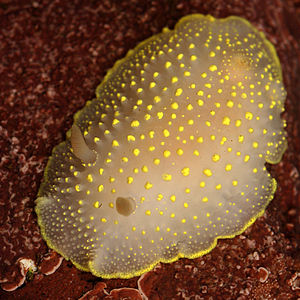Cadlinidae
| Cadlinidae | ||||||||||||
|---|---|---|---|---|---|---|---|---|---|---|---|---|

Cadlina luteomarginata : in front left the two rhinophores (antennae), behind right the anus |
||||||||||||
| Systematics | ||||||||||||
|
||||||||||||
| Scientific name | ||||||||||||
| Cadlinidae | ||||||||||||
| Bergh , 1891 |
The Cadlinidae are a family of star snails in the suborder of the nudibranchs . These are mostly medium-sized, exclusively marine, shellless snail species that eat sponges .
features
Like other star snails, the Cadlinidae usually have a flattened body with an oval body outline. In contrast to most of the similar Chromodorididae , the mantle bears tubercles (warts) and contains sclerites . The two feelers on the head, the rhinophores , are laminated. The gills around the anus on the back can be retracted in gill sheaths. The snails have a radula with many teeth, the posterior teeth of which all have numerous small teeth. The animals have a differentiated stomach. In contrast to the Chromodorididae, the penis of the Cadlinidae is provided with spines and the female sexual organs (vagina, bursa and receptaculum seminis) are arranged one behind the other.
Like other star snails, the Cadlinidae are hermaphrodites and mate with each other. They lay their eggs in egg strings from which numerous Veliger larvae hatch, feed on plankton and after a long pelagic phase they metamorphose into small star snails .
The Cadlinidae eat sponges .
distribution
The Cadlinidae occur in all oceans. In the North Sea they are represented by the magnificent smooth star snail ( Cadlina laevis ).
Systematics
In 1891, Rudolph Bergh set up a separate family Cadlinidae with the genus Cadlina described by him in 1878 in addition to the Chromodorididae . Since then, the relationship within the magnificent star snails has been discussed again and again, and the Cadlinidae were usually placed in the Chromodorididae family. In 2010 Rebecca Fay Johnson placed Cadlina again in a family Cadlinidae after molecular biological studies , but this time together with the genus Aldisa . This is one of five families in the superfamily Doridoidea . The family consists of two genera:
- Aldisa Bergh, 1878
- Cadlina Bergh, 1878 - Synonyms: Acanthochila Mörch, 1868; Echinochila Mörch, 1869; Inuda He. Marcus & Ev. Marcus, 1967; Juanella Odhner, 1921
literature
- Rebecca Fay Johnson: History of the Chromodorid Nudibranchs: Nomenclature, Phylogenetics, Biogeography and Classification . Dissertation, University of California, Santa Cruz. ProQuest, 2008. 215 pages. ( Google Books )
- Rebecca Fay Johnson (2010): Breaking family ties: taxon sampling and molecular phylogeny of chromodorid nudibranchs (Mollusca, Gastropoda) . Zoologica Scripta 40 (2), pp. 137-157. doi : 10.1111 / j.1463-6409.2010.00457.x .
- Robert D. Beeman, Gary C. Williams: Opisthobranchia and Pulmonata , in: Robert Hugh Morris, Donald Putnam Abbott, Eugene Clinton Haderlie: Intertidal Invertebrates of California . Pp. 308-354, here pp. 318-320, 14.21-14.25: Cadlina spp. Stanford University Press, 1st ed., Stanford (CA, USA) 1980. ( Google Books )
- Philippe Bouchet & Jean-Pierre Rocroi: Part 2. Working classification of the Gastropoda . Malacologia, 47: 239-283, Ann Arbor 2005 ISSN 0076-2997